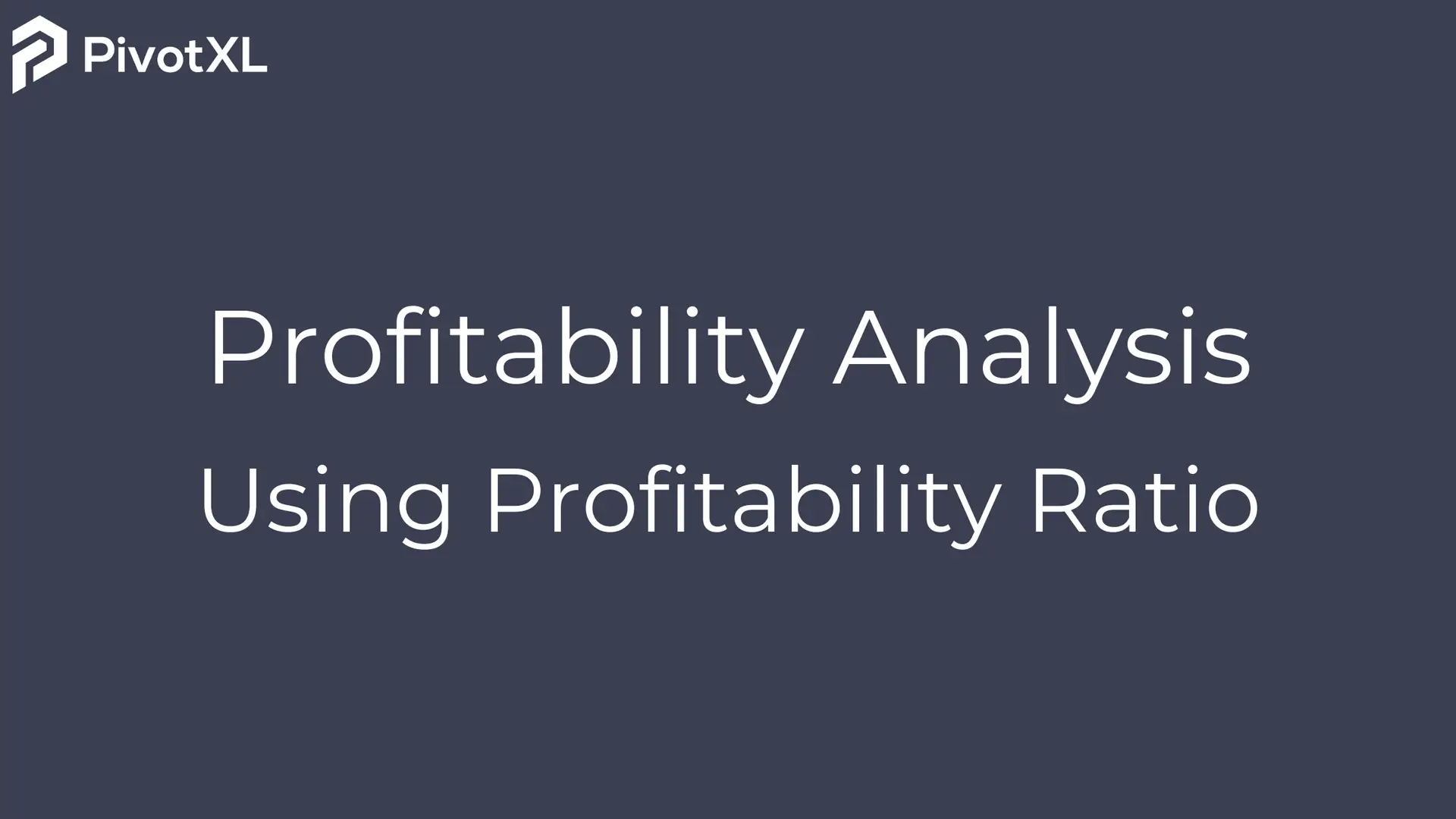Introduction
Understanding profitability ratio is essential for evaluating business performance and making informed financial decisions. These ratios provide insights into a company’s ability to generate profit relative to revenue, assets, and equity. By analyzing profitability ratio, businesses can identify strengths, weaknesses, and areas for growth.
PivotXL simplifies profitability analysis by providing real-time financial data, automated calculations, and dynamic reporting. This blog will explore key profitability ratio, their formulas, interpretations, and how businesses can leverage them for sustainable growth.
What Are Profitability Ratios?
Profitability ratios measure a company’s ability to generate profit relative to different financial metrics. These ratios are crucial for investors, financial analysts, and business leaders as they indicate the efficiency of operations and overall financial health.
Profitability ratios fall into two primary categories:
- Margin Ratios – Assess how much profit a company earns from its revenue.
- Return Ratios – Evaluate how well a company generates returns for its investors.
By tracking these ratios over time, businesses can make data-driven decisions to improve financial performance.
Key Profitability Ratios
The profitability analysis focuses on two primary types of ratios: margin ratios and return ratios. Both are crucial for assessing a company’s ability to generate profits, but they differ in their focus.
1. Margin Ratios
Margin ratios are metrics that assess a company’s profitability relative to its revenue at various stages of its income statement. These ratios give you insight into how much profit your business is generating from its core operations and how effectively it’s managing its costs.
The five key margin ratios include:
Gross Profit Margin Gross profit margin measures how much revenue is left over after deducting the cost of goods sold (COGS). This ratio provides an understanding of how efficiently a company is producing goods or services relative to the costs of production.
Gross Profit Margin = (Revenue – COGS) / Revenue * 100
Operating Profit Margin Operating profit margin reflects the percentage of revenue left after accounting for operating expenses like salaries, rent, and utilities, excluding interest and taxes. It shows the efficiency of a company’s core operations.
Operating Profit Margin = Operating Income / Revenue * 100
Net Profit Margin Net profit margin is perhaps the most comprehensive of the margin ratios. It measures the percentage of revenue that remains after all costs and expenses, including interest and taxes, have been deducted.
Net Profit Margin = Net Income / Revenue * 100
Cash Flow Margin Cash flow margin measures the percentage of cash a company generates relative to its revenue. This ratio is particularly useful for understanding how well a company is converting its profits into actual cash.
Cash Flow Margin = Cash Flow / Revenue * 100
EBITDA Margin EBITDA margin focuses on earnings before interest, taxes, depreciation, and amortization. It’s a measure of a company’s operating profitability and efficiency before non-operating costs are considered.
EBITDA Margin = EBITDA / Revenue * 100
2. Return Ratios
Return ratios, on the other hand, measure profitability in relation to the resources a company has invested, such as assets, equity, or capital. These ratios are particularly valuable for investors because they provide insight into the company’s ability to generate returns from its investments.
Key return ratios include:
Return on Assets (ROA) ROA measures how effectively a company is using its assets to generate profit. A higher ROA indicates more efficient use of assets.
Return on Assets (ROA) = Net Income / Total Assets * 100
Return on Equity (ROE) ROE reflects how much profit a company is generating relative to the equity invested by its shareholders. A higher ROE suggests that the company is using its shareholders’ capital efficiently.
Return on Equity (ROE) = Net Income / Shareholder’s Equity * 100
Return on Capital Employed (ROCE) ROCE assesses how efficiently a company generates profit from its capital employed (equity + long-term debt). A higher ROCE suggests that the company is generating good returns on the capital invested.
Return on Capital Employed (ROCE) = Operating Profit / Capital Employed * 100
Return on Investment (ROI) ROI measures the profitability of a specific investment relative to its cost. It’s often used to assess the success of particular projects or business initiatives.
Return on Investment (ROI) = (Return – Investment) / Investment * 100
Comparing Profitability Ratios with Efficiency Ratios
While profitability ratios measure how well a company can generate profit, efficiency ratios focus on how effectively a company is using its resources to generate those profits. Efficiency ratios often intersect with profitability, as better efficiency typically leads to higher profitability.
Examples of efficiency ratios include:
- Customer Acquisition Cost (CAC): Measures the cost of acquiring a new customer.
- Customer Lifetime Value (LTV): Calculates the total value a customer brings to a business over their lifespan.
- SaaS Rule of 40: For SaaS companies, the Rule of 40 suggests that a combination of growth rate and EBITDA margin should be at least 40%.
These ratios give an indication of how efficiently the company is allocating resources and its ability to improve profitability over time.
The Importance of Profitability Ratios in Different Industries
Different industries may place varying levels of emphasis on specific profitability ratios. For example, industries with high operational costs, like manufacturing, may focus more on gross profit margin, while industries with high capital requirements, like utilities, may focus more on return on capital employed (ROCE). Discussing these industry-specific differences will help readers understand how to tailor profitability analysis to their sector.
Example:
- Manufacturing: Gross Profit Margin is particularly important here because it provides insight into how efficiently the company is managing production costs.
- Tech/SaaS: Net Profit Margin and EBITDA Margin are more important because these companies often have high upfront investments and low operational costs.
Seasonality and Profitability
A company’s profitability may fluctuate due to seasonal trends. Businesses need to factor in seasonality when analyzing profitability ratio. For example, retail businesses typically see higher profits during holidays or special events, which should be accounted for when making profitability assessments. This section can explore how to adjust profitability ratio analysis for seasonal variations.
Example:
- Retailers: The net profit margin might be higher during holiday seasons, making it important to adjust year-round profitability analysis to avoid skewed conclusions.
Impact of Debt on Profitability
Debt plays a significant role in profitability, especially in capital-intensive industries. Businesses can use profitability ratio to evaluate the effectiveness of their debt management strategy. For example, return on capital employed (ROCE) can provide insights into whether debt is being used efficiently to generate profit.
Example:
- Leveraged companies: For highly leveraged companies, debt impacts net profit margin and ROI. Companies with high debt loads might have a lower ROE due to interest expenses, even if their overall profitability is solid.
Profitability Ratios in a Digital and Global Economy
The digital transformation and globalization of business have introduced new dynamics for profitability analysis. E-commerce companies, for instance, might have different operating cost structures compared to traditional businesses. This section could explore the impact of technology and global markets on profitability metrics and how businesses can adapt their analysis to these trends.
Example:
- E-commerce businesses: These businesses often face lower overhead costs and benefit from a global customer base. Gross profit margins can appear more favorable than in traditional brick-and-mortar businesses.
Evaluating Profitability in Early-Stage Startups
For early-stage startups, profitability analysis can be challenging. These companies often operate at a loss in their initial years before becoming profitable. In such cases, evaluating contribution margin and performing a break-even analysis can provide valuable insights into future profitability.
- Contribution Margin: This is the difference between the revenue from a customer and the variable cost incurred to serve them. It helps determine how much each customer contributes to covering fixed costs and generating profits.
- Break-Even Analysis: This helps determine the point at which total revenue equals total costs—when the company breaks even. By understanding the break-even point, early-stage companies can better set sales targets and adjust pricing strategies accordingly.
How to Perform Profitability Analysis for Your Business
Performing a thorough profitability analysis involves several key steps:
- Gather Financial Data: You need access to financial statements such as the income statement, balance sheet, and cash flow statement. Additionally, data on customer acquisition costs and lifetime value should be collected.
- Calculate Break-Even Point: If your company is pre-revenue or not yet profitable, calculating the break-even point is essential. This helps set sales targets and pricing strategies.
- Conduct Ratio Analysis: Use the data to calculate profitability ratios. These ratios provide a numerical understanding of your company’s financial health.
- Benchmarking: Compare your results against industry benchmarks to see how your performance aligns with the market. This will help identify strengths and weaknesses.
- Interpret Results: After calculating ratios and comparing with benchmarks, interpret the results to make decisions on pricing, cost management, and potential growth strategies.
The Challenges of Profitability Analysis
While profitability analysis is a powerful tool, it does come with challenges, including:
- Inaccurate Cost Allocation: Improper allocation of costs can lead to misleading profitability results.
- Data Accuracy: Incomplete or erroneous financial data can skew results.
- Indirect Costs: Overlooking indirect costs such as overhead can lead to overestimating profitability.
- Time Value of Money: Companies must account for the time value of money to ensure an accurate profitability picture.
Overcoming Challenges with Technology
To simplify profitability analysis, businesses should consider using financial planning and analysis (FP&A) software. These tools streamline the process of gathering and analyzing data, helping businesses overcome the challenges associated with manual calculations.
FP&A platforms can help automate tasks like data consolidation, improving accuracy and saving time.
Conclusion
Mastering profitability analysis through profitability ratio is crucial for sustainable business growth. By regularly tracking and optimizing these key financial metrics, businesses can enhance operational efficiency, improve financial health, and drive long-term success.
PivotXL simplifies profitability analysis with real-time financial insights, automation, and advanced reporting, allowing businesses to make informed decisions with confidence.
Start leveraging profitability ratios today to unlock your company’s full growth potential.




